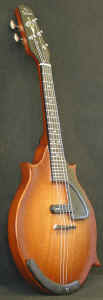 |

|
||||||||||||||||||||||||||||
|
Instrument Reviews
CD & Book Reviews
|
Weber Maverick Review
By
Sound to Earth,
the company behind Weber mandolins, is one of the most respected
names in the mandolin business. Founded by former employees of Flatiron
and Gibson Montana, Sound to Earth has brought its experience and
talent to bear on a wide range of mandolin-family instruments, winning
renown for its double-edged dedication to clean, tradition-informed
design coupled with innovative engineering. Although the company
is one of the largest domestic mandolin builders, its products all
display the fit, finish, and craftsmanship of handbuilt instruments.
Until 2005, though, I didn’t have a specific reason to talk about Weber instruments on this Web site. But that year Vern Brekke, the Sound to Earth engineer already renowned for the company’s improved bridge and tailpiece designs, unveiled the Maverick—his take on a 5-string solidbody electric mandolin. Every bit as impressive as the other Weber products, the Maverick continues and extends Sound to Earth’s commitment to tradition and innovation. The mahogany body and neck, with twin points on the upper bouts, bring to mind the Gibson EM200, although a third body point and a snakehead headstock give the Maverick its own identity. Innovation shows up in the contoured ebony pickguard, which cleverly conceals the tone and volume knobs as well as a 3-position coil switch, affording you the ability to get series, parallel, and single-coil sounds out of the DiMarzio dual-blade humbucker. Hiding the controls in this way not only keeps the design cleaner, it also gives the player unparalleled access to those controls. A simple ebony tailpiece extends along the bass bout to serve double duty as an armrest, and the custom-machined bridge is fully adjustable for intonation. The Maverick comes standard with a simple matte finish, but I suspect you have only to ask about sunbursts and custom colors. Diamond fret markers, a 6-point star headstock inlay, and distinctive Grover nickel tuners finish the look—and of course you get a nicely padded Weber F-style case with crushed-velvet interior … one of the nicest-looking cases in the business if you ask me. Brekke has kept playability in mind at every turn. The 14-inch radiused fretboard and jumbo frets make for clean fingering work, and should feel comfortable to most mandolin players. The single-string spacing feels very natural, and allows for easy whole-step bends if that’s your bag. I was also impressed with the DiMarzio pickup: strong, balanced signal, minimal noise, and fairly versatile, thanks to the switch. If I needed to make smooth transitions between, say, a twangy sound for chords and a beefier one for lead breaks, the Maverick is an instrument I could quickly grow to love. Without any effects, its tone is appropriate for jazz, country, or Western swing. With effects, who knows? As with nearly every instrument of this type at this scale length, the C string is a bit wobbly. But only a tiny bit: adjust the saddle as far toward the tailpiece as possible, then lighten up your pick attack and make sure your left-hand fingers approach the string from straight above (not the side), and you’ll find that you can easily control the C. I must stress that it feels and sounds a lot better than many other 5-strings of similar dimensions. At $2,295 retail, the Maverick falls at a high-midrange price point as electric mandolins go. But for your money, you’re getting an aesthetically pleasing design that’s also highly functional and player-proven. I can think of instruments I’ve seen for only a little less that weren’t quite ready for prime time in terms of setup and playability. The Maverick, on the other hand, is everything a solidbody electric mandolin was meant to be—plus a few things no one had thought of before.
Rating:
|
